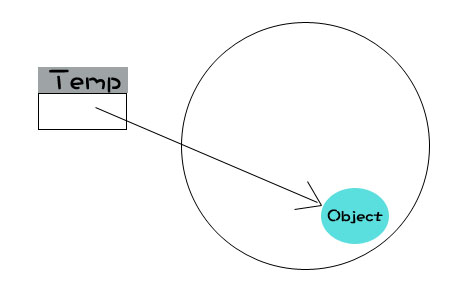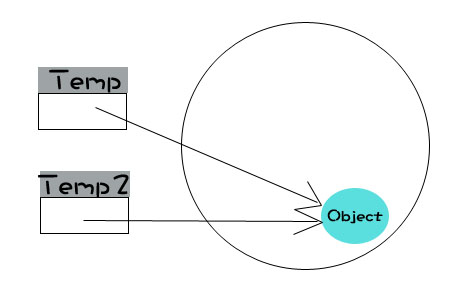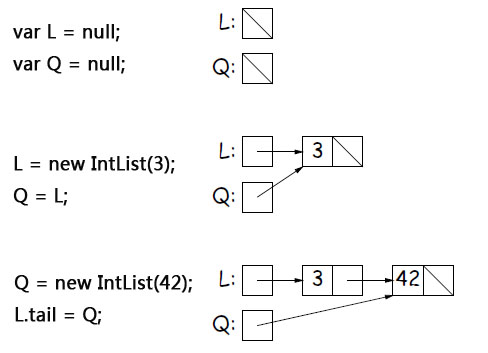Heim >Web-Frontend >js-Tutorial >Javascript引用指针使用介绍_javascript技巧
Javascript引用指针使用介绍_javascript技巧
- WBOYWBOYWBOYWBOYWBOYWBOYWBOYWBOYWBOYWBOYWBOYWBOYWBOriginal
- 2016-05-16 17:48:481141Durchsuche
请尝试完成下列完形填空:
复制代码 代码如下:
/* 创建一个队列,头为head0,尾为tail0 */
function IntList(head0, tail0){
this.head = head0 || 0;
this.tail = tail0 || null;
}
/* 返回一个IntList包含数组中的所有数 */
IntList.list = function(__args){
var sentinel = new IntList(),
len = __args.length,
p = sentinel;
for(var i = 0; i p.tail = new IntList(__args[i]);
p = p.tail;
}
return sentinel.tail;
};
/* 返回该对象的字符串表示 */
IntList.prototype.toString = function(){
var temp = "";
temp += "[";
for(var L = this; L !== null; L = L.tail){
temp = temp + " " + L.head;
}
temp += " ]";
return temp;
};
/** 返回一个IntList,包含IntList A和IntList B,
* 其中B的元素在A的后面。不能使用new关键字。
*/
function dcatenate(A, B){
/* 完成功能 */
}
/** 返回一个新的IntList,其长度为len,
* 以#start元素为开头(其中#0是第一个元素),
* 不能改变L。
*/
function sublist(L, start, len){
/* 完成功能 */
}
这是一个用Javascript写的链表题。由于链表拥有较为复杂的引用操作,正好可以用来考察下对Javascript的引用的理解。附带简单的测试用例:
复制代码 代码如下:
/* 测试dcatenate和sublist函数是否正确 */
function test(){
var A = IntList.list([4,6,7,3,8]),
B = IntList.list([3,2,5,9]);
dcatenate(A, B);
if(A.toString() === "[ 4 6 7 3 8 3 2 5 9 ]"){
alert("dcatenate函数正确。");
}else{
alert("dcatenate函数错误。");
}
var L = IntList.list([3,4,5,2,6,8,1,9]),
result = sublist(L, 3, 3);
if(result.toString() === "[ 2 6 8 ]"){
alert("sublist函数正确。");
}else{
alert("sublist函数正确。");
}
}
Javascript引用?
实际上,在对变量赋予引用类型实例时,变量保存的是该实例的引用:
var temp = new Object();

这种表现非常切合它的名字,引用类型,其实例当然是来引用的。
而当将该变量再付给另一个变量的时候,实际上只是进行了对引用的复制操作:
var temp2 = temp;

所以虽然从定义式来看:temp2 = temp,但他们并没有直接联系,例如修改了temp的引用:
复制代码 代码如下:
var temp = {
name: "temp"
};
var temp2 = temp;
temp = {
name: "not temp2"
};
temp === temp2; //false
当然,如果我们修改的只是指针指向的实例本身,那么temp2依然等于temp:
复制代码 代码如下:
var temp = {
name: "temp"
};
var temp2 = temp;
temp.name = "also temp2";
temp === temp2; //true
IntList是什么东东?
我们来分析一下下图:

- 创建两个空的变量,所以右图中L和Q是空的。创建一个新的IntList其头部为3,尾部为空,将L引用的值赋给Q,所以L和Q都指向这个新的IntList。Q指向一个新创建的IntList其头部为42,尾部为空,将Q的指针赋给L.tail,这样两个IntList被套嵌起来。
可见IntList是个通过指针达到多重套嵌的数据结构,被称为链表(Linked List)。
1.创建两个空的变量,所以右图中L和Q是空的。2.创建一个新的IntList其头部为3,尾部为空,将L引用的值赋给Q,所以L和Q都指向这个新的IntList。
3.Q指向一个新创建的IntList其头部为42,尾部为空,将Q的指针赋给L.tail,这样两个IntList被套嵌起来。
可见IntList是个通过指针达到多重套嵌的数据结构,被称为链表(Linked List)。
IntList合并
我们只需要将其中一个的尾部指向另一个就行了。这样这两个IntList就连接起来了:
复制代码 代码如下:
/** 返回一个IntList,包含IntList A和IntList B,
* 其中B的元素在A的后面。不能使用new关键字。
*/
function dcatenate(A, B){
var p;
for(p = A; p != null; p = p.tail){
if(p.tail === null){
p.tail = B;
break;
}
}
return A
}
IntList截取
由于题目要求不能改变原IntList,所以我们只能从原IntList取出数据再重建一个新的数据。
复制代码 代码如下:
/** 返回一个新的IntList,其长度为len,
* 以#start元素为开头(其中#0是第一个元素),
* 不能改变L。
*/
function sublist(L, start, len){
var K,
P,
J;
var i = 0,
end = start + len;
for(P = L; i if(i continue;
}else if(i === start){
K = new IntList(P.head);
J = K;
}else if(i > start && i J.tail = new IntList(P.head);
J = J.tail;
}else if(i >= end){
break;
}
}
return K;
}
思考题
1.函数传参数的时候是怎么传的?例如下面代码的引用过程是怎样的?
复制代码 代码如下:
var obj = {
name: "anything"
};
function getName(__obj){
return __obj.name;
}
var name = getName(obj);
Stellungnahme:
Der Inhalt dieses Artikels wird freiwillig von Internetnutzern beigesteuert und das Urheberrecht liegt beim ursprünglichen Autor. Diese Website übernimmt keine entsprechende rechtliche Verantwortung. Wenn Sie Inhalte finden, bei denen der Verdacht eines Plagiats oder einer Rechtsverletzung besteht, wenden Sie sich bitte an admin@php.cn
Vorheriger Artikel:JS TextArea字符串长度限制代码集合_javascript技巧Nächster Artikel:Jquery瀑布流插件使用介绍_jquery
In Verbindung stehende Artikel
Mehr sehen- Eine eingehende Analyse der Bootstrap-Listengruppenkomponente
- Detaillierte Erläuterung des JavaScript-Funktions-Curryings
- Vollständiges Beispiel für die Generierung von JS-Passwörtern und die Erkennung der Stärke (mit Download des Demo-Quellcodes)
- Angularjs integriert WeChat UI (weui)
- Wie man mit JavaScript schnell zwischen traditionellem Chinesisch und vereinfachtem Chinesisch wechselt und wie Websites den Wechsel zwischen vereinfachtem und traditionellem Chinesisch unterstützen – Javascript-Kenntnisse

